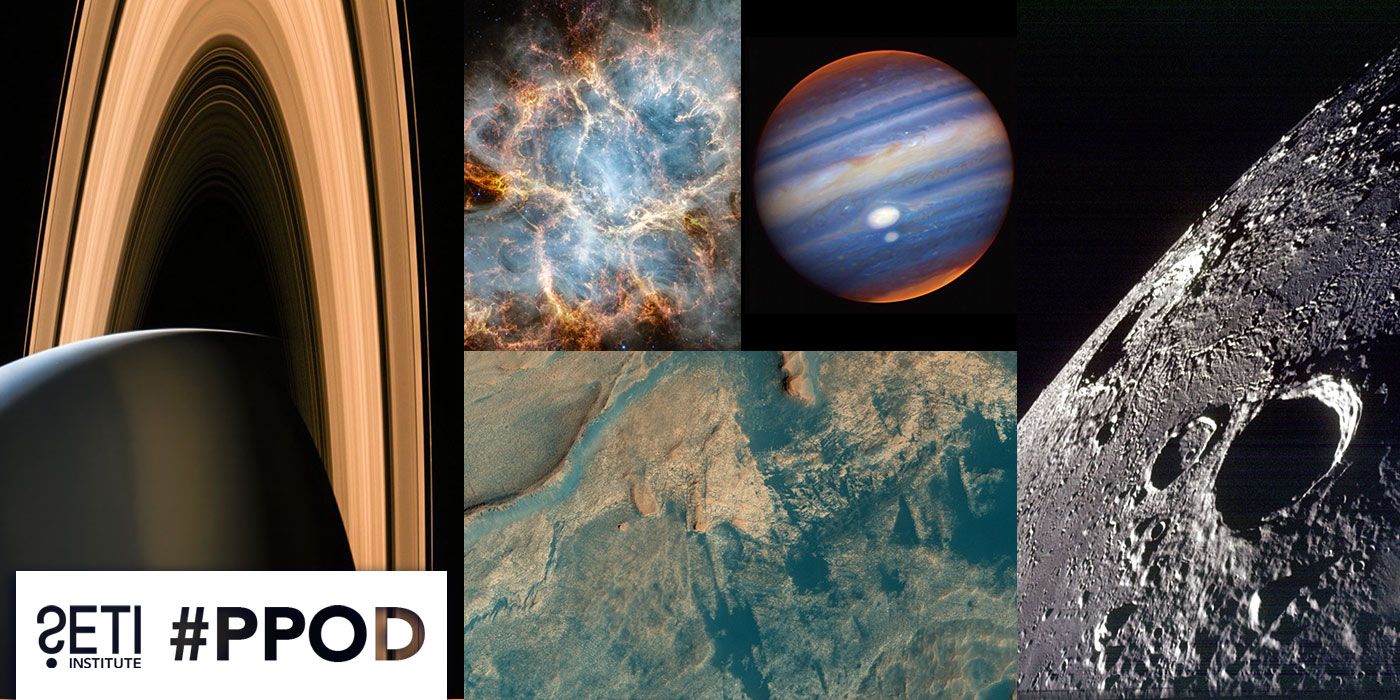
Planetary Picture of the Day
Week of November 13, 2023
The Moon, Mars, Jupiter, and Saturn provide a feast of planetary imagery, and the latest from JWST shows off the gorgeous Crab Nebula.
Monday, November 13, 2023

Ringshine
This near-infrared view of Saturn and the rings was taken by NASA's Cassini spacecraft in July 2017. Saturn is also showing ‘ringshine’, light reflected off the rings and onto the night side of the planet.
Tuesday, November 14, 2023

Close Encounter of Jupiter's Red Spots
This 2006 Gemini Observatory image shows Jupiter’s two giant “red” spots brushing past one another in the planet’s southern hemisphere. The near-infrared image incorporates adaptive optics to correct for, in real-time, most of the distortions caused by turbulence in the Earth’s atmosphere. The result is a view from the ground that rivals images from space.
In the near-infrared, the red spots appear white rather than the reddish hue seen at visible wavelengths. Both red spots are massive storm systems. The top of the larger one, known for a long time as the Great Red Spot, lies about 8 kilometers above the neighboring cloud-tops and is the largest hurricane known in the solar system.
The smaller storm (officially called Oval BA, but informally known as Red Spot Junior) is another hurricane-like system but was temporary and is no longer a feature in Jupiter’s clouds. Red Spot Junior was roughly half the size of its famous cousin, but its winds blew just as strong. This mighty storm formed between 1998 and 2000 from the merger of three long-enduring white ovals, each a similar storm system at a smaller scale, which had been observed for at least 60 years.
But it was not until February 27, 2006, that Philippine amateur astronomer Christopher Go discovered that the color of the newly formed white oval had turned brick red. Astronomers were witnessing the birth of a new red spot. No one is certain why this white oval turned red. However, University of Hawai‘i astronomer Toby Owen supports a hypothesis developed by New Mexico State University astronomer Reta Beebe, suggesting that the merger of the three white ovals led to an intensified storm system.
Wednesday, November 15, 2023

A Speck of Curiosity
If you look carefully, you can see a small, bright object just left of center in this image. Can you spot it? That's NASA's Curiosity rover, photographed from Mars orbit. This image (only a small part of which is shown here) was taken by the HiRISE camera onboard NASA's Mars Reconnaissance Orbiter (MRO) on 18 April 2021. The image has a resolution of 25 cm per pixel, and north is up. At the time the image was taken, MRO was 269 km above the rover.
Thursday, November 16, 2023

Copernicus Crater and the Carpathian Mountains on the Moon
This oblique view of the Moon was taken from the Lunar Module during the Apollo 12 mission on 1969-11-19 and shows the 107 km diameter Copernicus crater near the horizon at the center of the frame. Reinhold crater, 42 km across, is in the foreground. The Carpathian mountain range is visible on the horizon at the lower left. This area is just to the north of the Apollo 12 landing site. The view is looking northeast.
Friday, November 17, 2023

Crab Nebula (NIRCam and MIRI Image)
NASA’s James Webb Space Telescope has gazed at the Crab Nebula in the search for answers about the supernova remnant’s origins. Webb’s NIRCam (Near-Infrared Camera) and MIRI (Mid-Infrared Instrument) have revealed new details in infrared light.
Similar to the Hubble optical wavelength image released in 2005, with Webb the remnant appears comprised of a crisp, cage-like structure of fluffy red-orange filaments of gas that trace doubly ionized sulfur (sulfur III). Among the remnant’s interior, yellow-white and green fluffy ridges form large-scale loop-like structures, which represent areas where dust particles reside.
The area within is comprised of translucent, milky material. This white material is synchrotron radiation, which is emitted across the electromagnetic spectrum but becomes particularly vibrant thanks to Webb’s sensitivity and spatial resolution. It is generated by particles accelerated to extremely high speeds as they wind around magnetic field lines. Trace the synchrotron radiation throughout the majority of the Crab Nebula’s interior.
Locate the wisps that follow a ripple-like pattern in the middle. In the center of this ring-like structure is a bright white dot: a rapidly rotating neutron star. Further out from the core, follow the thin white ribbons of the radiation. The curvy wisps are closely grouped together, following different directions that mimic the structure of the pulsar’s magnetic field. Note how certain gas filaments are bluer in color. These areas contain singly ionized iron (iron II).





